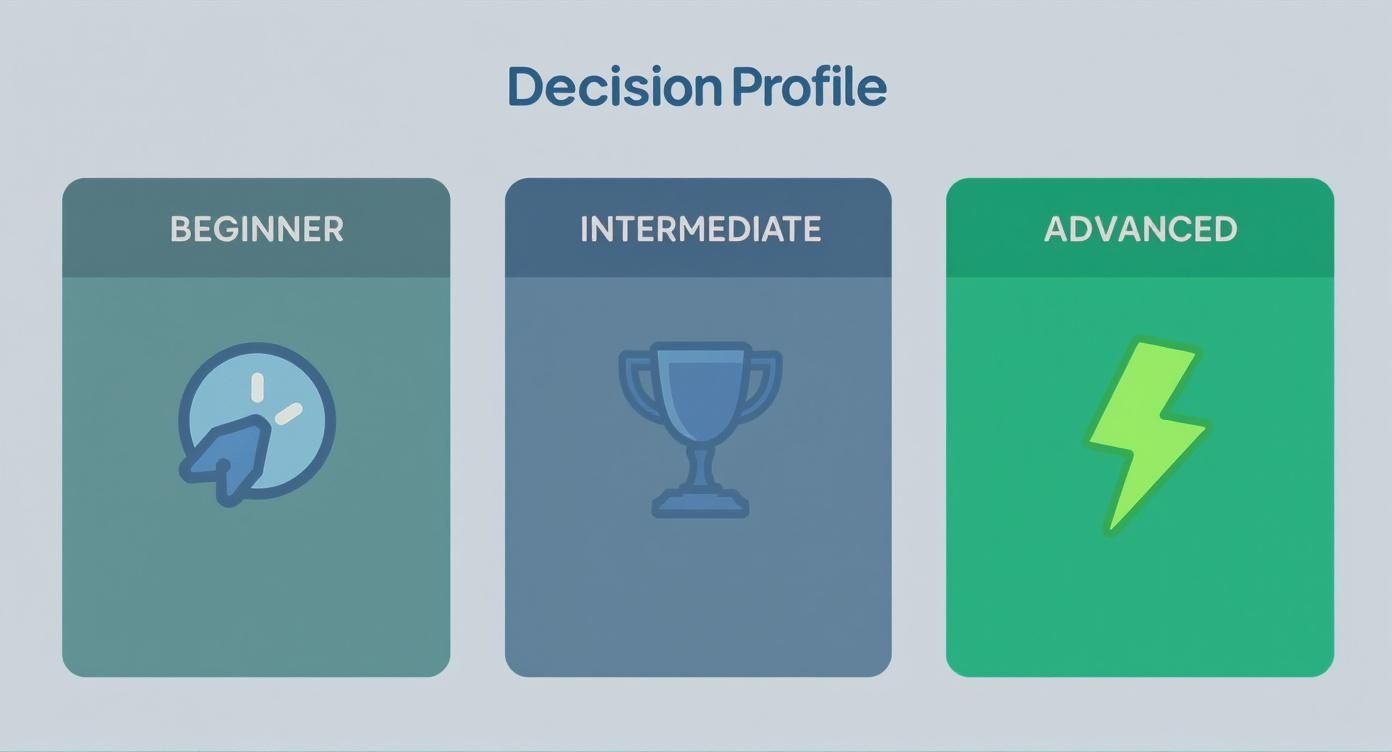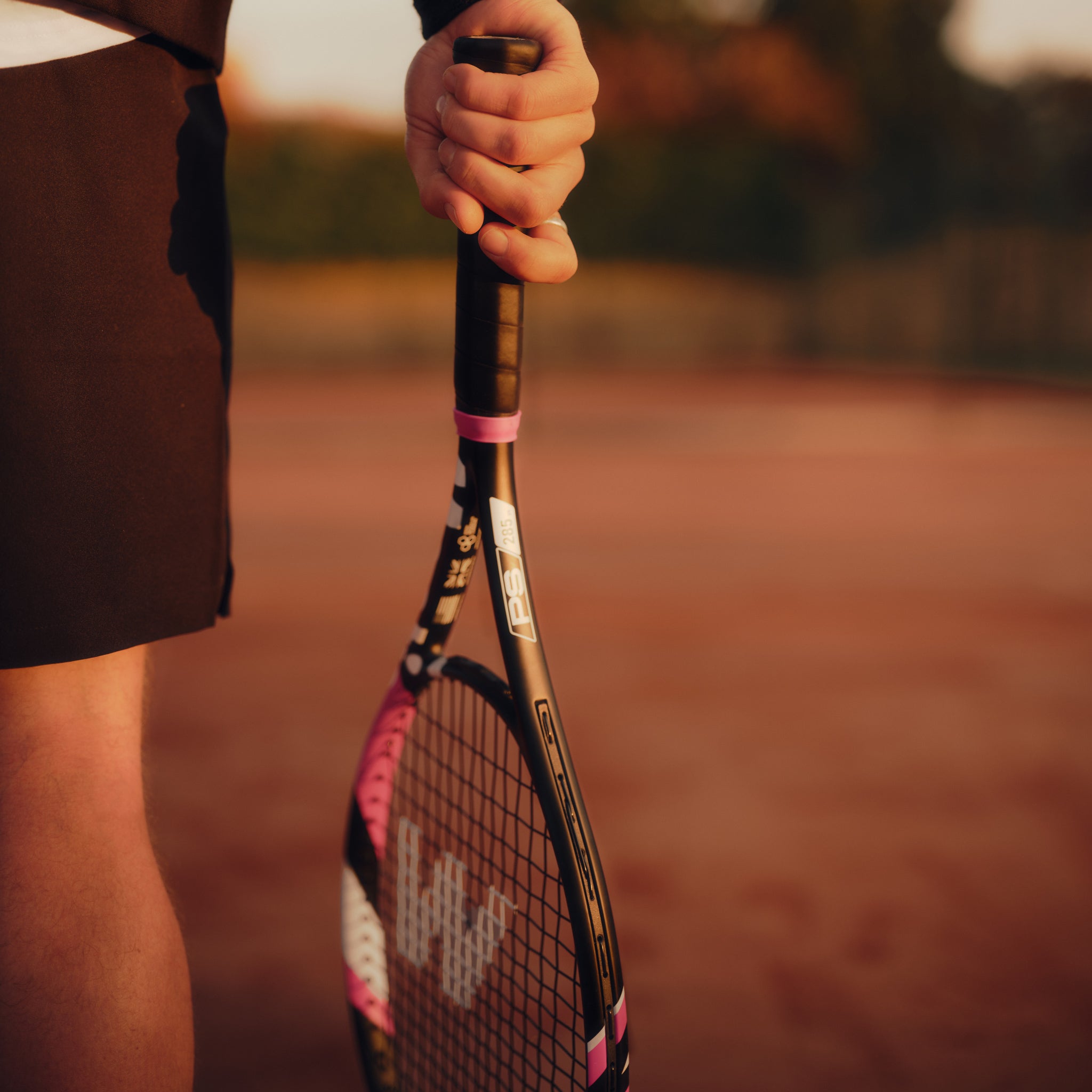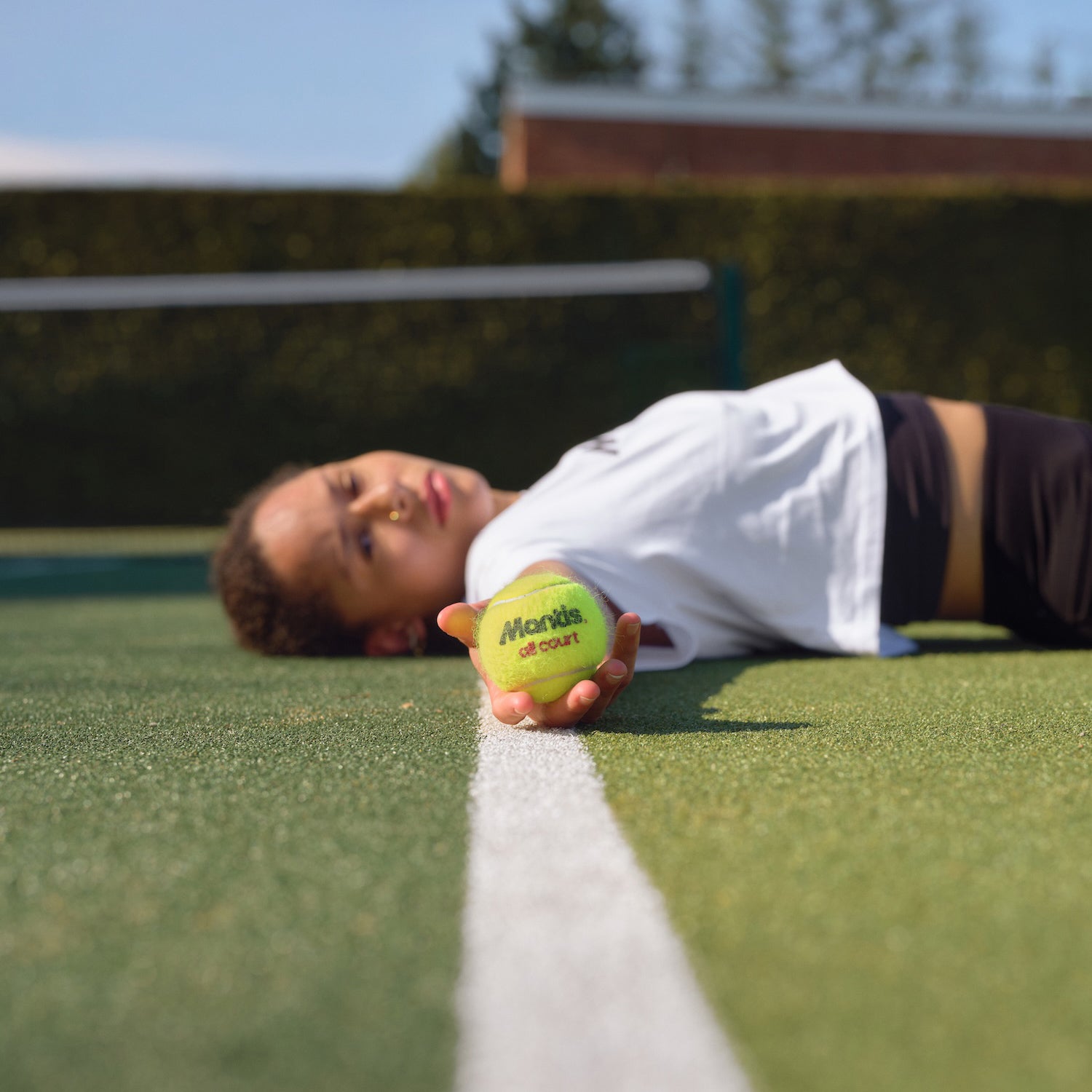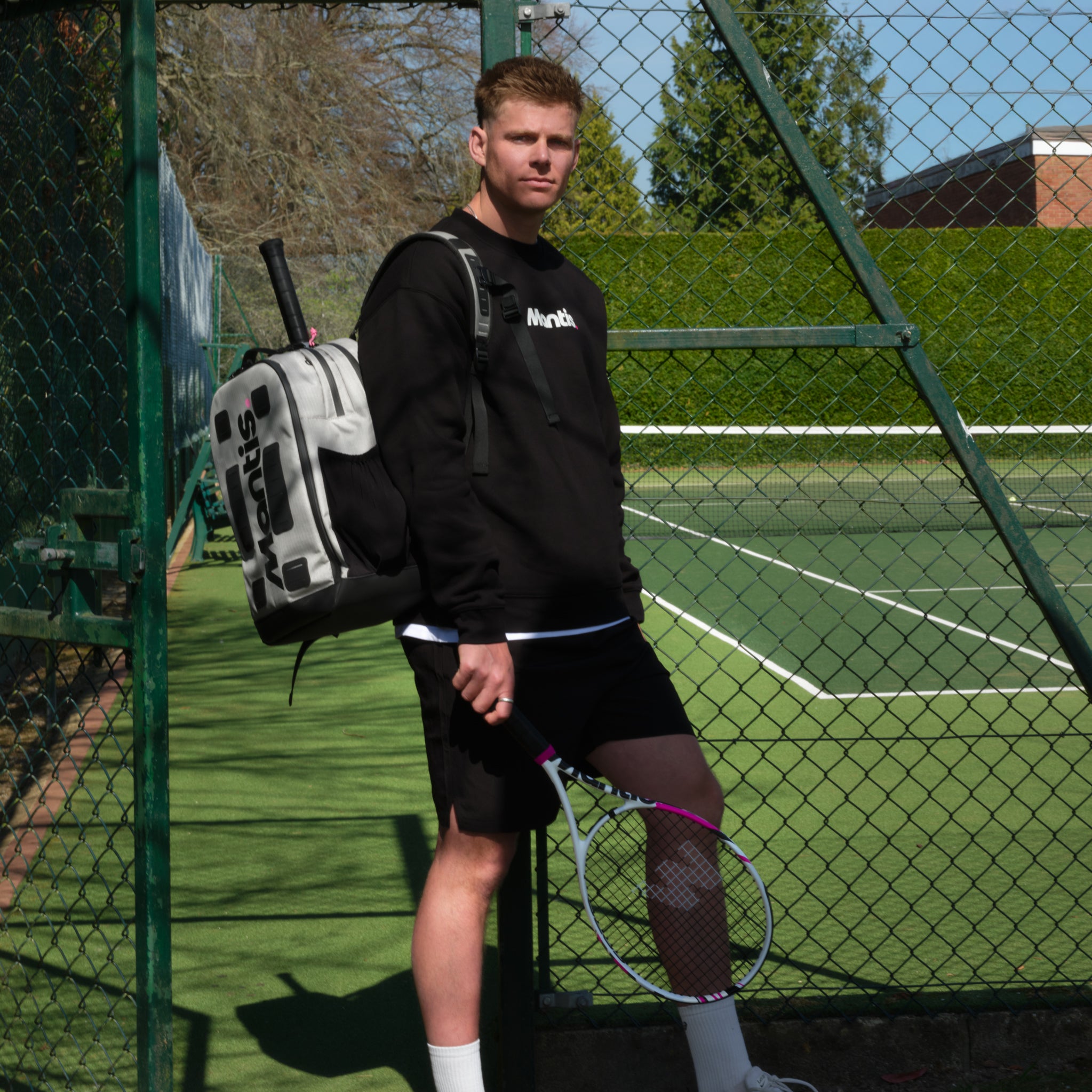
When you're hunting for the best tennis rackets for tennis elbow, you’re really looking for frames built with comfort in mind. At Mantis, we find the best options are flexible frames, larger head sizes, and technology designed to dampen vibration. Making the right choice is a huge part of both recovery and prevention because the equipment in your hands directly impacts the forces travelling up your arm. For a deeper dive into preventative measures, we’ve put together a detailed guide on how to prevent tennis elbow.
How Your Racket Choice Affects Tennis Elbow
Understanding the direct link between your racket and that nagging elbow pain is the first step toward playing comfortably again. The discomfort we call tennis elbow is more than just an annoyance; it’s a clear signal that the tendons in your forearm are under too much strain, and your equipment is often a major culprit.
Every time you hit the ball, a shockwave travels from the strings, through the racket, and right into your arm. An unsuitable frame acts like an amplifier for these forces, sending jarring feedback straight to the muscles and tendons around your elbow. This is especially true on off-centre hits, which we all make.
The Physics of Pain and Prevention
The condition, known medically as lateral epicondylitis, is a classic repetitive strain injury. While things like poor technique and lack of conditioning play a role, your racket's specifications can either ease the problem or make it much worse. Four specs are particularly critical:
- Frame Stiffness (Flex): A stiffer frame is powerful but brutally honest—it transfers more shock straight to your arm. A more flexible frame, on the other hand, bends slightly on impact, absorbing much of that vibration before it ever reaches you.
- Weight and Balance: Heavier rackets are inherently more stable and soak up impact much better, though they can be tiring over a long match. Lighter rackets are easy to swing but can vibrate like a tuning fork. The sweet spot is a stable, yet manageable, weight.
- Head Size: A larger head gives you a bigger ‘sweet spot’. This makes the racket far more forgiving on those off-centre shots, which are a major source of harsh, elbow-aggravating vibrations.
- String Pattern and Tension: Looser string tensions and more open string patterns create a softer stringbed. This allows the ball to sink in for a split second longer, which helps to dampen the initial impact forces.
At Mantis, we believe selecting the right equipment isn't just for recovery; it’s a powerful tool for prevention. An arm-friendly racket is designed to absorb impact, not transmit it.
Racket Specifications and Elbow Health
To put it simply, here’s what to look for and why:
| Racket Feature | Impact on Tennis Elbow | Recommendation |
|---|---|---|
| Frame Stiffness | High stiffness amplifies shock. | Choose a flexible frame (look for a low RA rating). |
| Head Size | A small head size punishes off-centre hits. | Go for a larger head size (100+ sq. in.). |
| Weight | Too light offers poor stability and vibrates more. | Select a moderate weight with a head-light balance. |
Ultimately, the best rackets for tennis elbow are those that work with your body, not against it. By understanding how these core features influence the forces on your arm, you can make a smarter choice that puts both your performance and your long-term joint health first.
Decoding Specification of The Best Tennis Rackets for Tennis Elbow
When you're looking for a racket that's kind to your elbow, you need to look past the marketing hype and get into the raw specs. At Mantis, we believe that understanding the numbers is the key to making a choice that helps your game and your long-term arm health. Once you know how to read things like head size and frame stiffness, you can pick up any racket and get a real sense of its potential, just like the experts do on platforms like Racket Business.
This is our breakdown of the most important features to consider if you're managing any elbow discomfort. The goal here is simple: to show you exactly how each specification changes the forces that travel up your arm with every single shot.
The Importance of a Larger Head Size
One of the most forgiving things a racket can offer is a generous head size. Any frame with a surface area over 100 square inches has a much bigger sweet spot—that prime real estate on the string bed where contact feels pure.
Hitting the ball off-centre is a major cause of those jarring vibrations that shoot straight to your elbow. A larger sweet spot gives you a much bigger margin for error, which means even your slightly mishit shots feel more stable and produce far less shock. That forgiveness is absolutely crucial for reducing the cumulative stress on your forearm tendons over a long match.
Understanding Frame Stiffness and RA Rating
Frame stiffness, usually shown as an RA rating, is probably the most direct measure of how much shock a racket either absorbs or passes on to you. The RA (Racket A) scale measures how much a frame bends on impact. A high number means a stiff, powerful frame; a lower number means a more flexible, comfortable one.
For anyone with elbow concerns, a lower RA rating (typically below 65) is what you should be looking for.
- Stiff Frames (RA 68+): These will give you plenty of power, but they transfer a huge percentage of the impact shock straight into your arm.
- Flexible Frames (RA below 65): These frames bend just enough on contact to absorb and disperse harsh vibrations before they reach your elbow. This ‘pocketing’ effect not only makes for a more comfortable hit but can also improve your feel for the ball.
Choosing a flexible frame is like adding suspension to your car; it smooths out the bumps. A stiff frame, by contrast, makes you feel every single imperfection in the road.
Racket Weight and Balance: The Delicate Act
The relationship between a racket's total weight and its balance point is subtle but absolutely vital for arm safety. It’s a common myth that the lightest racket possible is always the best for an injury. In reality, an ultra-light frame just doesn't have enough mass to stand up to the ball's impact, often feeling unstable and buzzy.
The sweet spot for tennis elbow is often a moderately weighted frame (around 280-310 grams strung) with a head-light balance. This setup provides enough mass to stay stable and soak up shock, but because the weight is shifted towards the handle, it still feels easy to swing. Crucially, it stops the racket from twisting in your hand on off-centre shots—a key trigger for elbow strain.
How String Patterns Influence Feel
Finally, the string pattern plays a big part in the racket's overall feel. An open string pattern (like 16x19) has more space between the strings. This allows them to move more freely and pocket the ball for a split second longer.
This increased 'dwell time' creates a softer, plusher feeling at impact and helps to dampen vibrations. On the other hand, a dense pattern (like 18x20) offers more control but creates a firmer, less forgiving stringbed that can feel pretty harsh on a sensitive arm.
Comparing Modern Vibration Dampening Technologies
Beyond the core specs of a racket, the battle against tennis elbow is often won or lost in the finer details of its construction. At Mantis, we know that modern brands have engineered all sorts of specialised systems designed to absorb shock and mute harmful vibrations. Getting your head around these different approaches is crucial to finding a frame that truly looks after your arm.
These technologies aren't just marketing buzzwords; they represent different philosophies on how to handle impact forces. Some focus on embedding soft, shock-absorbing materials directly into the carbon layup of the frame itself. This approach is all about dissipating vibrations right at the point of impact, before they can even think about travelling down to the handle.
Others concentrate on reinventing the grommet system or the handle. By creating more flexible grommets or developing handle constructions that isolate the frame from your grip, these designs work to intercept shockwaves much closer to your hand. Each method has its own distinct feel and effectiveness, and what feels perfect for one player might not be the best fit for another.
Frame-Integrated Dampening Systems
Many of the most popular arm-friendly rackets today have dampening materials built right into the frame. This is usually done by weaving flexible materials like basalt, special graphite composites, or proprietary elastomers into the carbon fibre layers at strategic points, such as the head and the shaft.
The real beauty of this method is its subtlety. The dampening feels like it’s just part of the racket’s personality, rather than an add-on. For example, a frame might use a special foam core inside the hoop to soak up impact energy. The result is a muted, solid feel that doesn't completely sacrifice feedback from the ball. This approach gives you a consistent level of comfort no matter where on the stringbed you make contact.
Handle and Grommet Innovations
An alternative strategy is all about stopping vibrations just before they reach your hand. This is where specialised handle systems and innovative grommet designs come into play. Some brands have developed handles with separate, cushioned components or layers of shock-absorbing polymer that act as a buffer between the raw frame and your grip.
The core idea behind handle-based technology is to isolate the player's hand from the frame's raw feedback. It’s an effective way to filter out the high-frequency vibrations that are most irritating to an already sensitive elbow.
Similarly, advanced grommet systems can allow for greater string movement on impact. This not only makes the sweet spot feel bigger but also helps the stringbed absorb more of the ball’s energy, cutting down the initial shock that travels through the frame. These small but important features make a huge difference to the overall comfort of a racket. For a deeper dive into how these accessories work, you can learn more about tennis racket dampeners in our dedicated article.
Ultimately, the best technology for you comes down to personal preference. Do you prefer a frame that feels inherently soft and muted from the get-go, or one that uses a specific component to filter out the harshness? Experimenting with different systems is the only way to find the one that gives you the confidence to swing freely, without that nagging fear of aggravating your elbow.
Why Grip Size and Strings Are Non-Negotiable
It’s easy to focus on the racket frame, but when it comes to managing tennis elbow, two other components are just as critical: your grip size and your strings. We see it all the time at Mantis – players overlook these details, but they directly influence how you hold the racket and absorb the shock of every single ball strike.
Getting the grip size wrong is probably one of the most common and damaging mistakes a player can make. If your grip is too small, you have to squeeze it constantly just to stop the racket from twisting in your hand on impact. That non-stop tension leads to tired muscles in your forearm and puts a huge amount of strain on the tendons connecting to your elbow.
And a grip that’s too big isn’t any better. It stops your wrist from moving naturally and makes it harder to whip the racket head through the ball, forcing your arm to do all the work. Either way, you’re creating a fast track to elbow pain.
Finding Your Perfect Grip Size
The good news is that measuring your grip size is simple, and you can do it right now at home. This is one of the quickest ways to get real, useful data that helps you pick gear that actually works for your body.
- Open your hitting hand and lay it flat, with your fingers held straight and together.
- Grab a ruler and measure from the bottom horizontal crease in your palm up to the tip of your ring finger.
- That measurement is your grip size. For instance, a measurement of 4 3/8 inches is a size 3 grip, which is a fairly common size for many male players.
UK clinical advice consistently points to grip size optimisation as a primary factor in managing tennis elbow. When you combine the right grip with a suitable racket, the improvement in symptoms can be significant.
The Critical Role of Strings and Tension
Think of your strings as the first line of defence. They’re the first thing to make contact with the ball, and their material and tension level dictate how that impact feels. For anyone worried about their elbow, the choice is simple: you have to go for softer strings.
- Softer Strings: Materials like multifilament and natural gut are leagues more elastic than the stiff polyester strings many players use. They stretch more when the ball hits, soaking up a huge amount of shock and creating a much softer, more comfortable feel.
- Lower Tension: Stringing these softer options at a lower tension—say, around 48-52 lbs—amplifies the effect. It allows the ball to sink into the stringbed for longer, which dampens vibrations and gives you a bigger, more forgiving sweet spot.
From a UK clinical practice perspective, the best rackets for tennis elbow often have a lighter mass and an optimised grip size to prevent overuse injuries. When physiotherapy is paired with the right equipment—including arm-friendly strings—studies report up to 80% improvement in symptoms. It's worth exploring more about these clinical findings to see just how much ergonomic changes can help.
Matching Racket Specs to Your Player Profile
Choosing one of the best tennis rackets for tennis elbow isn’t as simple as grabbing the most flexible frame you can find. At Mantis, we know from experience that a player's style, level, and physical condition all play a huge part in figuring out which specs will actually help. To get a broader picture, it's worth reading our guide on how to prevent tennis elbow.
There’s no magic bullet here. The perfect setup for a beginner with a tender arm is going to be worlds apart from what a competitive player needs to soften the feel without losing performance. That's why we break it down by player profile, helping you pinpoint the combination of features that will support your arm and suit your game.
The Developing Beginner with a Sensitive Arm
If you're new to the game or just have a particularly sensitive arm, your top priorities should be forgiveness and comfort. The main goal is to dampen the harsh feedback from off-centre hits, which are just a part of the learning process.
For this player, you want a racket that does most of the heavy lifting when it comes to absorbing shock.
- Head Size: Go for an oversize head of 105 sq. inches or more. This gives you a massive sweet spot, making the racket incredibly forgiving on mishits.
- Weight & Balance: A lighter frame, somewhere between 260-285 grams (unstrung), combined with a head-heavy balance, provides stability without feeling like a log to swing.
- Frame Stiffness: A very low RA rating (below 64) is crucial. It ensures the frame flexes nicely on impact, soaking up vibrations before they reach your arm.
The Intermediate Club Player Managing Flare-ups
Intermediate players have their strokes dialled in but might still get elbow pain, especially after a long match or a tough practice session. You need a racket that finds that sweet spot between comfort and control, letting you play your game without worrying about re-injury.
The trick is finding a balanced frame that protects your arm but doesn’t feel vague or disconnected from the ball.
A classic mistake for this player is to use a stiff, powerful racket that their technique can't quite handle consistently. We always suggest a frame that offers arm-friendly comfort without a big drop in performance.
Here’s a solid combination to look for:
- Head Size: A midplus head size of 100-104 sq. inches offers a great mix of power and forgiveness.
- Weight & Balance: A moderate weight (285-300 grams unstrung) with a head-light balance gives you both stability and manoeuvrability.
- Frame Stiffness: A flexible to medium-flex frame (RA of 64-67) will provide a comfortable response at contact.
The Advanced Competitor Needing a Softer Feel
Advanced players with long, fast swings generate their own power. But after a long, competitive season, even they might look for a softer-feeling frame to reduce the cumulative stress on their arm. The challenge is they can't afford to give up the control and feedback they depend on.
This profile requires a sophisticated blend of flexibility and stability, a combination you’ll typically find in more premium frames.
The ideal specs usually look something like this:
- Head Size: A smaller head size of 98-100 sq. inches is all about precision and control.
- Weight & Balance: A heavier weight (305+ grams unstrung) paired with a distinctly head-light balance provides rock-solid stability against heavy hitters.
- Frame Stiffness: A low RA rating (below 65) is key to delivering that plush, connected feel that lets you know exactly what the ball is doing.
To make things a bit clearer, here’s a quick-reference table that brings all these recommendations together. Think of it as a starting point to help you narrow down your search based on where you are in your tennis journey.
Arm-Friendly Racket Specification Guide by Player Level
| Player Profile | Recommended Head Size (sq. in.) | Recommended Weight (unstrung) | Recommended Balance | Ideal Frame Stiffness (RA) |
|---|---|---|---|---|
| Developing Beginner | 105+ | 260-285g | Head-Heavy | Below 64 |
| Intermediate Player | 100-104 | 285-300g | Head-Light | 64-67 |
| Advanced Competitor | 98-100 | 305g+ | Very Head-Light | Below 65 |
Remember, these are guidelines, not rigid rules. The best racket is always the one that feels right in your hand and allows you to play with confidence and without pain. Use this guide to inform your choices, but always trust your own feel on the court.
Frequently Asked Questions
When you're dealing with elbow pain, navigating the world of tennis equipment can throw up a lot of questions. Here at Mantis, we've gathered some of the most common queries to give you clear, straightforward answers and help you make the best decision for your arm.
Before diving in, remember that the right racket is just one piece of the puzzle. For those already feeling a twinge, understanding all the effective tennis elbow treatment options is a vital first step that works hand-in-hand with choosing the right gear.
Can Changing My Racket Alone Cure Tennis Elbow?
Switching to an arm-friendly racket is a huge step forward in managing and preventing tennis elbow, but it's very rarely a standalone cure. The right frame makes a massive difference by reducing the shock and vibration your arm has to deal with, which in turn helps ease symptoms and lower the risk of making things worse.
However, a full recovery almost always needs a more rounded approach. This usually means refining your swing technique, doing specific strengthening and stretching exercises for your forearm, and making sure you get enough rest. Think of the right racket as a critical part of the solution, not the whole solution itself.
This decision tree shows how racket recommendations can change depending on a player's level.

As you can see, the ideal specs for avoiding elbow pain look quite different for beginner, intermediate, and advanced players.
Is a Heavier or Lighter Racket Better?
This is a classic point of confusion, and the answer really comes down to finding the right balance. A very light racket is easy to swing, sure, but it doesn't have the mass to absorb impact, meaning more of that shock travels straight up your arm. On the flip side, a very heavy one is great at absorbing shock but can lead to muscle fatigue, causing your form to break down and creating strain.
The sweet spot for tennis elbow is often a racket of moderate weight (around 280-310 grams strung) that has a 'head-light' balance. This gives you enough mass for stability at impact while still being easy to manoeuvre.
This kind of setup stops the racket from twisting in your hand on off-centre hits—a major culprit for jarring vibrations.
How Much Do Arm-Friendly Rackets Typically Cost?
Thankfully, you don't have to break the bank to find a comfortable racket. The cost of an arm-friendly frame is generally in line with standard performance rackets, with prices typically ranging from around £100 to over £200.
There are plenty of excellent mid-range options that deliver the key features you need for elbow protection, like a flexible frame and a generous head size. It’s far more important to focus on finding the specifications that suit your game and your body than it is to fixate on the price tag.
At Mantis, we are dedicated to providing expertly crafted equipment for players who live for the game. Explore our range of performance rackets, balls, and accessories designed with purpose and precision. Find your perfect gear at https://mantissport.com.










